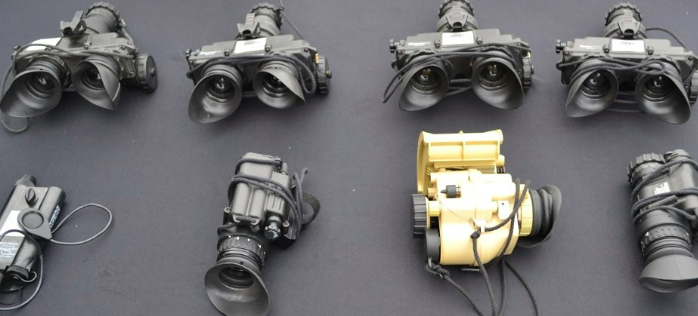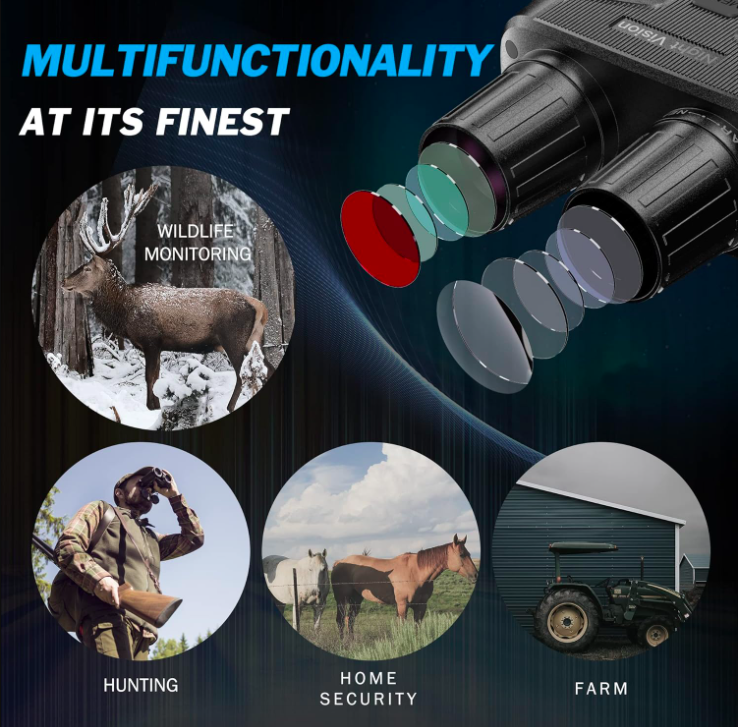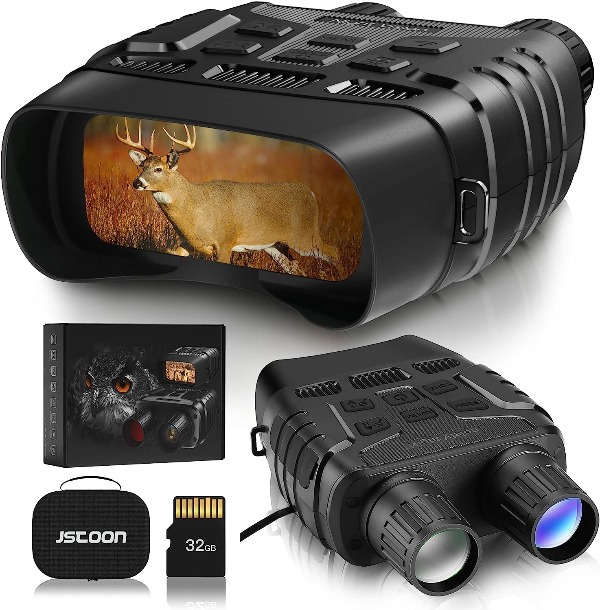In the realm of optical innovations, night vision technology stands as a paragon of human ingenuity.
This remarkable advancement has revolutionized our ability to perceive and navigate in low-light conditions, opening up a nocturnal world previously shrouded in darkness. From its inception in military applications to its widespread adoption in civilian sectors, night vision has undergone a transformative journey, continually pushing the boundaries of what's possible in visual perception.

The Evolution of Night Vision: From Military to Civilian Use
The genesis of night vision technology can be traced back to the crucible of World War II. Initially developed as a clandestine military asset, these early devices were bulky and rudimentary. As the technology matured, it transcended its martial origins, finding myriad applications in civilian life. This metamorphosis from a strictly military tool to a versatile civilian technology has been nothing short of remarkable. Today, night vision devices are ubiquitous in fields ranging from wildlife observation to security and surveillance.
Check out how mainstream versions work on Amazon.com >>
Decoding Night Vision Goggles vs. Night Vision Binoculars
Key Differences and Similarities
While both night vision goggles and binoculars serve the primary function of enhancing visibility in low-light conditions, they possess distinct characteristics. Goggles, typically head-mounted, offer hands-free operation and a wider field of view. Binoculars, conversely, provide superior magnification and are often more versatile in varying light conditions. Despite these differences, both utilize similar core technologies to amplify available light.
Choosing the Right Device for Your Needs
Selecting between goggles and binoculars hinges on the specific application. For activities requiring mobility and constant awareness of one's surroundings, goggles are paramount. Binoculars excel in stationary observation scenarios where detailed examination of distant objects is crucial. Factors such as ergonomics, battery life, and durability should also be weighed in the decision-making process.
Digital Infrared Night Vision: A Game-Changer in Low-Light Observation
How Digital Infrared Technology Works
Digital infrared night vision represents a quantum leap in low-light imaging. This technology harnesses the power of infrared light, which is invisible to the naked eye but abundant in the night environment. Sophisticated sensors capture this infrared radiation, converting it into a visible image through complex algorithms. The result is a clear, detailed representation of the nocturnal world, often with startling clarity.
Advantages Over Traditional Night Vision Systems
The advent of digital infrared systems has ushered in a new era of night vision capabilities. These devices offer superior image quality, reduced noise, and enhanced contrast compared to their analog predecessors. Moreover, digital systems often incorporate features like image capture, video recording, and wireless connectivity, expanding their utility beyond mere observation.
Navigating 100% Darkness: The Ultimate Test for Night Vision Equipment
Overcoming Complete Blackout Conditions
The pinnacle of night vision technology lies in its ability to function in absolute darkness. Advanced systems can amplify even the faintest traces of light, such as that emitted by distant stars, to create a visible image. In scenarios of total blackout, some devices employ active infrared illuminators to project invisible light, which is then captured and processed by the night vision system.
Real-World Applications and Scenarios

The capacity to see in pitch darkness has profound implications across various fields. In military operations, it provides a crucial tactical advantage. For search and rescue teams, it can mean the difference between life and death. Wildlife researchers utilize this technology to observe nocturnal animal behaviors without disturbing their natural patterns. The applications are as diverse as they are impactful.
HD 1080p Image Quality: Bringing Clarity to the Night
The Importance of High-Resolution Imaging
The integration of high-definition technology into night vision devices marks a significant milestone. HD 1080p resolution offers unprecedented detail and clarity, allowing users to discern fine textures and subtle movements that would be imperceptible with lower-resolution systems. This level of detail is crucial in applications ranging from wildlife photography to security surveillance.
Comparing HD Night Vision to Standard Definition
The disparity between HD and standard definition night vision is stark. HD systems provide crisper images with better color reproduction (in color night vision modes) and superior contrast. This enhanced visual fidelity not only improves the user experience but also increases the effectiveness of night vision in critical applications where detail can be of utmost importance.
Impressive Range: Viewing from 300m/984ft Away
Breaking Down the Long-Range Capabilities
The ability to observe objects at distances of 300 meters or more is a testament to the advanced optics and image processing capabilities of modern night vision devices. This long-range performance is achieved through a combination of high-quality lenses, sensitive sensors, and sophisticated image enhancement algorithms. Such range capabilities expand the utility of night vision across various applications, from border surveillance to long-distance wildlife observation.
Factors Affecting Distance Performance
Several variables influence the effective range of night vision equipment. Ambient light levels, atmospheric conditions, and the size and reflectivity of the target all play crucial roles. Additionally, the quality of the device's optics and sensors, as well as the power of any integrated infrared illuminators, significantly impact long-range performance. Understanding these factors is essential for optimizing the use of night vision technology in different environments.
Hunting in the Dark: Revolutionizing Nocturnal Pursuits
Ethical Considerations for Night Hunting
The application of night vision technology in hunting has sparked debates regarding ethics and fair chase. While it undeniably enhances a hunter's capabilities, it also raises questions about the balance between technological advantage and traditional hunting skills. Responsible use of night vision in hunting requires adherence to local regulations and a strong ethical framework.
Best Practices for Using Night Vision While Hunting
Effective and ethical use of night vision in hunting demands a nuanced approach. Hunters must familiarize themselves with their equipment's capabilities and limitations. Proper target identification is paramount to ensure safety and compliance with game laws. Additionally, hunters should consider the impact of their activities on nocturnal wildlife behaviors and ecosystems.
Surveillance and Security: Enhancing Nighttime Monitoring
Professional Applications in Law Enforcement
Night vision technology has become an indispensable tool in law enforcement. It enables covert surveillance operations, enhances officer safety during nighttime patrols, and aids in evidence gathering. Advanced systems with recording capabilities provide valuable documentation for legal proceedings. The integration of night vision with other technologies, such as thermal imaging, further expands its utility in complex security scenarios.
Home Security Solutions Using Night Vision Technology
The democratization of night vision technology has led to its incorporation into home security systems. Modern security cameras equipped with night vision capabilities offer homeowners unprecedented 24/7 monitoring of their property. These systems can detect and record nocturnal activities, serving both as a deterrent to potential intruders and as a means of documenting any security breaches.
The Science Behind Infrared Night Vision
Understanding Infrared Light and Its Properties
Infrared light, occupying the electromagnetic spectrum beyond visible red light, is a cornerstone of night vision technology. This invisible radiation is emitted by all objects above absolute zero temperature, with warmer objects emitting more infrared energy. Night vision devices exploit this phenomenon, detecting and amplifying these infrared emissions to create visible images.
How Infrared Sensors Capture and Process Images
Infrared sensors in night vision devices are marvels of modern engineering. These sensors, typically made from materials like indium gallium arsenide or mercury cadmium telluride, are exquisitely sensitive to infrared radiation. They convert detected infrared energy into electrical signals, which are then processed and amplified to produce a visible image. Advanced image processing algorithms further enhance these images, adjusting contrast, reducing noise, and sharpening details.
Durability and Weather Resistance: Built for the Outdoors
Rugged Design Features for Harsh Environments
Modern night vision devices are engineered to withstand the rigors of outdoor use. Robust housings, often constructed from high-impact polymers or aircraft-grade aluminum, protect sensitive internal components. Shock-absorbing designs mitigate the effects of impacts and vibrations, ensuring reliability in challenging conditions. Some advanced models incorporate features like internal gyroscopes for image stabilization, further enhancing their usability in dynamic environments.
Waterproofing and Fog-Proofing Technologies
To ensure functionality in diverse weather conditions, high-quality night vision devices employ sophisticated waterproofing and fog-proofing technologies. O-ring seals and gaskets prevent water ingress, while internal nitrogen purging eliminates moisture, preventing lens fogging. These features are crucial for maintaining optical clarity and protecting sensitive electronic components in humid or wet conditions.
Power and Battery Life: Staying Operational Through the Night
Energy-Efficient Technologies in Modern Night Vision Devices
The quest for extended operational time has driven significant advancements in power management for night vision equipment. Modern devices incorporate low-power electronics and efficient LED illuminators to minimize energy consumption. Some cutting-edge models utilize power-saving modes that adjust performance based on ambient light conditions, further extending battery life.
Tips for Maximizing Battery Performance in the Field
To optimize battery life during extended operations, users should employ strategies such as using external power banks for recharging, carrying spare batteries, and utilizing power-saving modes when appropriate. In cold environments, keeping batteries warm can significantly improve their performance. Some advanced users even integrate solar charging solutions for prolonged field use.
Advanced Features: Beyond Basic Night Vision
Built-in Recording Capabilities
Many contemporary night vision devices offer integrated recording functions, allowing users to capture still images and video footage. This feature is invaluable for documentation, training, and evidence gathering. Advanced models may include high-capacity internal storage or support for external memory cards, enabling hours of continuous recording.
Wi-Fi Connectivity and Smartphone Integration
The integration of Wi-Fi technology in night vision devices represents a paradigm shift in functionality. This feature enables real-time streaming of images and video to smartphones or tablets, facilitating remote viewing and control. Some devices offer dedicated mobile apps that provide additional features like image enhancement, geotagging, and seamless sharing of captured content.
Ergonomics and Comfort: Designed for Extended Use
Lightweight Materials and Balanced Construction
The evolution of night vision technology has seen a concurrent advancement in ergonomic design. Modern devices utilize lightweight materials such as reinforced polymers and titanium alloys to reduce overall weight. Careful attention to weight distribution and balance minimizes user fatigue during prolonged use. Ergonomically designed controls and intuitive interfaces further enhance usability, especially in low-light conditions.
Adjustable Features for Personalized Fit
Recognizing the diversity of user physiologies, advanced night vision devices incorporate a range of adjustable features. These may include adjustable interpupillary distance settings, diopter adjustments for individual eye focus, and customizable eye relief. Head-mounted systems often feature multiple adjustment points to ensure a secure and comfortable fit across a wide range of head sizes and shapes.
Legal Considerations: Navigating Regulations and Restrictions
Understanding Local Laws on Night Vision Equipment
The legal landscape surrounding night vision technology is complex and varies significantly across jurisdictions. In some regions, the possession and use of night vision devices are strictly regulated, particularly for civilian applications. Users must be cognizant of local laws regarding the ownership, use, and transportation of night vision equipment. Some jurisdictions may require special permits or licenses for certain types of devices or applications.
Export Regulations and International Travel Concerns
Night vision technology often falls under stringent export control regulations due to its potential military applications. International travelers must be aware of the legal implications of transporting night vision devices across borders. Some countries may prohibit the import of certain types of night vision equipment or require special documentation. Failure to comply with these regulations can result in severe legal consequences, including confiscation of equipment and potential criminal charges.
Maintenance and Care: Preserving Your Night Vision Investment
Cleaning and Storage Best Practices
Proper maintenance is crucial for ensuring the longevity and performance of night vision devices. Lenses should be cleaned regularly using specialized optical cleaning solutions and microfiber cloths to avoid scratches. When not in use, devices should be stored in a cool, dry environment, preferably in a protective case. For long-term storage, batteries should be removed to prevent potential damage from leakage.
Troubleshooting Common Issues
Users should familiarize themselves with common troubleshooting procedures. Issues like image distortion, excessive noise, or inconsistent performance can often be resolved through simple adjustments or maintenance. Regular firmware updates, when applicable, can address software-related issues and sometimes introduce new features or improvements.
Comparing Night Vision Generations: Gen 1 vs. Gen 2 vs. Gen 3 vs. Digital
Technological Advancements Across Generations
The evolution of night vision technology is often categorized into generations, each marking significant advancements in performance and capabilities. Gen 1 devices, the earliest commercial night vision technology, offered basic light amplification but suffered from image distortion and limited range. Gen 2 introduced the micro-channel plate, significantly improving image quality and light amplification. Gen 3 devices, utilizing gallium arsenide photocathodes, provide superior image resolution and performance in extremely low light conditions. Digital night vision, while not part of the traditional generational classification, represents the latest technological paradigm, offering unique advantages in image processing and feature integration.
Choosing the Right Generation for Your Application
Selecting the appropriate night vision generation depends on the specific requirements of the intended application. While Gen 3 devices offer the highest performance, they come at a premium cost and may be subject to stricter regulations. Gen 2 devices offer a balance of performance and affordability suitable for many civilian applications. Digital night vision, with its rapidly advancing capabilities, is becoming an increasingly attractive option, especially for users who value features like recording and connectivity.
Are Amazon Night Vision Goggles Worth It? This video buys a pair for $200 and explains the use cases they may work for. The takeaway is vs a proper night vision goggle at $3000 they are of course not comparable.
The Future of Night Vision Technology
Emerging Trends and Innovations
The field of night vision technology continues to evolve at a rapid pace. Current research focuses on enhancing sensitivity, reducing size and power consumption, and improving image quality. Emerging technologies like quantum dot sensors promise to push the boundaries of low-light imaging capabilities. Integration with augmented reality systems is another frontier, potentially revolutionizing how users interact with and interpret night vision imagery.
Potential Advancements on the Horizon
Looking ahead, the future of night vision technology is brimming with possibilities. Advancements in materials science may lead to ultra-thin, flexible night vision sensors that can be integrated into everyday items like eyeglasses or contact lenses. Artificial intelligence and machine learning algorithms could enhance image processing, potentially enabling night vision systems to automatically identify and track objects of interest. As these technologies mature, the line between natural vision and technologically enhanced sight may become increasingly blurred, opening up new realms of human perception and capability.
Citations: [1] https://en.wikipedia.org/wiki/Night_vision [2] https://www.bushnell.com/through-the-lens/bu-blog-blog-how-does-night-vision-work-the-science-behind-it.html [3] https://www.nightvision.com.au/the-history-of-night-vision-technology/ [4] https://www.agmglobalvision.eu/blog/evolution-of-night-vision-technology [5] https://www.comsol.com/blogs/evolution-night-vision-technology [6] https://www.agmglobalvision.com/When-Was-Night-Vision-Invented-and-by-Who [7] https://www.reddit.com/r/NightVision/comments/gnfm1j/binos_vs_goggles/ [8] https://www.nightvision4less.com/education-center-night-vision-devices.aspx [9] https://www.optics-trade.eu/blog/night-vision-goggles-vs-night-vision-binoculars/ [10] https://nightvisiongoggles.co.uk/advantages-and-disadvantages-of-digital-night-vision-systems/ [11] https://gloomgroup.com/blogs/night-vision-info/night-vision-digital-vs-analog [12] https://www.scottcountry.co.uk/night-vision-riflescope-buyers-guide [13] https://www.geeksforgeeks.org/night-vision-technology/ [14] https://www.blackview.hk/blog/guides/what-is-night-vision-technology [15] https://www.smithsonianmag.com/innovation/seeing-dark-history-night-vision-180963357/ [16] https://www.militaryaerospace.com/communications/article/16709910/the-evolution-of-night-vision-devices [17] https://www.pointoptics.com/difference-between-night-vision-goggles-and-night-vision-binoculars/ [18] https://nightfoxstore.com/pages/product-comparison [19] https://www.optics4birding.com/thermal-imaging-digital-night-vision.aspx [20] https://reolink.com/blog/night-vision-vs-infrared/


